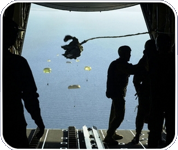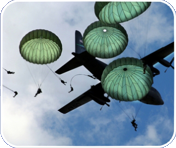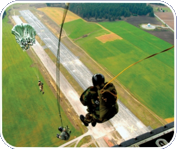Operation Eagle 2007
When I first set eyes upon the An – 2 Colt bi-plane, my first thought was that thing would never get off the ground. As I approached the aircraft, my intuitions seemed plausible based on the amount of oil in the drip pan underneath the engine. But looks can definitely be deceiving. As the engines fired, a cloud of exhaust filled the craft. Smiles crossed the faces of all paratroopers. The engines coughed, choked, and whined. Several prayers later, we were airborne. Worries had departed. And all were looking forward to the first jump.
I have to admit, the space inside the Colt was accommodating. I had plenty of elbow room and didn’t have to worry about static line entanglements as I approached the open door. The view was spectacular as I steadied myself into a good door position. Relaxed and ready to go, I made eye contact with the jumpmaster who assured all was in order. Given the OK, I leaped into the fresh air of the Slovakian countryside.
Surprisingly, there was little, if any, wind resistance. I had a clean exit and only one twist in my suspension lines. I was jumping the Slovakian canopy system. I enjoyed the camouflage pattern of the Czechoslovakian OVP -68 canopy and I found the steering to closely model that of the MC1-1C that I had jumped several times while assigned to American Long Range Reconnaissance Patrols. We exited at an altitude of 700 meters AGL. It was the right altitude to experiment with the handling of the canopy and to enjoy the view of Dubnica DZ. It was easy to gauge the wind direction as there was only a slight breeze, so I slipped facing into the wind and prepared to execute a good parachute landing fall (PLF). Back on the ground (only 10 meters from the turn in point) I thanked God and quickly worked my way out of the harness. It was a great jump.
That night, we relaxed over an excellent dinner and had a couple of good Slovakian beers. All remained focused for the next day’s jumps so we went to bed early. Again, the next day, we would jump the An – 2 Colt. I needn’t worry about the plane becoming airborne. It was definitely a reliable airplane. Sleep came easily that night.
No worries the next day as we rehearsed our PLFs and continued to refresh actions in the aircraft and malfunction procedures. On this jump, I would use the Polish Kadet canopy system. Once airborne, the adrenaline continued to course through my veins. I stumbled a little at the door but managed to regain composure and assume a better door position. I was thankful that the jumpmasters were safety conscience and did not hurry me to exit the aircraft. Believe it or not, even after the graceful movement toward the door, I had absolutely no twists this time. The orange and white canopy was totally captivating and I found the Kadet to have a greater steering capacity (a much sharper turn radius) and a faster descent. I would highly recommend this system to experienced static line jumpers and to members of smaller, commando-type units that prefer smaller drop zones.
Again, after another successful day of jumping, we relaxed at night and prepared for our journey the next day to Spiska Nov Ves to jump from an Mi – 8 helicopter.
The Mi – 8 is an aircraft that has a very rustic appeal. The majority of my jumps have been from the ass end of a CH – 47 so I felt very comfortable transitioning to this frame. Again, there was plenty of room and the procedures for exiting were basically simple: hand off your static line, walk towards the tail of the aircraft, and bunny hop outward and upward while assuming a good, tight body position. Very simple. Very quick. Very enjoyable. I will say this, the scenery surrounding the Spiska Nova Ves DZ is very captivating. The mountains were stunning, the winds across the valley were invigorating, and the ladies pouring the beer were well-bred. Following our jumps, we were awarded our foreign parachutist badges. The wings as well as the certificates are truly pieces of art.
I have had the opportunity to jump with foreign militaries before; however, I will say that this band of brothers bonded immediately. All levels of jumpers were represented from the novice to the master. As an American, I felt very relaxed within this group. I was also embarrassed that I was the only one who spoke only one language (English) and my British companion remarked that I butchered that language as well. Seriously, though, the language barrier was not an issue. Jumps were conducted in a safe and professional manner. I would strongly recommend this tour to anyone desiring to experience military parachute jumping with a totally Eastern European flare. Even if the jumps would have been scratched, the camaraderie and fellowship were well worth the investment.
Thanks to Stefan for a job well-done.
Francis
Back to Overview of Reports






